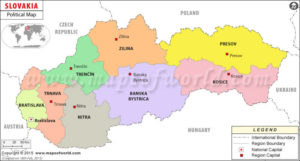Bratislava – Cleveland
Written by Ezra Ellenbogen


Cuyahoga County has a reasonably large Slovak population; in fact, it has the highest of any county in Ohio, and Ohio is the state with the second-highest Slovak population overall.[1] In short, Cleveland and surrounding areas have a significant Slovak population.
Among Cleveland’s many great sister cities, there is Bratislava, which is the capital of and largest city in Slovakia. Cleveland and Bratislava have been sister cities since 1990[2], but the commitment to helping each other and creating an international dialogue has fallen off track. The most recent involvements were in 2015 when the Cleveland Philharmonic performed in Bratislava and a major meeting was held in Cleveland.[3] These programs proved beneficial and successful and could most likely have such an effect again today. The 2010-2014 mayor of Bratislava, Milan Ftáčnik, stated[4] that “this document [the sister city agreement], which was written by both mayors, was unfortunately not so much fulfilled by concrete activities.” In spite of his efforts at reconnecting the cities, we have become distant neighbors yet again. Nowadays, both sides are looking for chances to reconnect; mayors from both cities have attempted to revive the ‘sister city attitude’ that would help them thrive. However, the two cities are barely connected, despite sharing heritage; communications and flights between them are difficult.
Since then, most relations have been on a higher level between Slovakia and the US instead of between Bratislava and Cleveland, though in unrelated contexts. While this may have provided firm relations between the two countries – which are now friendly – the use of the sister city program to focus on countries at a local level makes it easier to share skills. One such example was Cleveland’s work with Bahir-Dar, Ethiopia, when they shadowed Cleveland’s medical transport to improve the efficiency of their own systems. These types of partnerships could easily help the entire country when applied and can be reciprocal, especially with large cities or capital cities. Even these specialized relations can be considered diplomatic, as they open paths for Slovakia and the United States to exchange ideas and people through local programs. With the two culturally rich cities in question, it seems that such a project would be wondrous.
The reasons for reopening relations between Cleveland and Bratislava include diplomacy, population similarities, Slovak heritage pride, and, as Milan Ftáčnik expressed when he tried to re-open relations last time: “because we believe that the cities of equal size and equal problems and have to learn from each other how to solve them.” This was greatly relevant when he said this in 2012, but even more so now with the friendliness of the two nations and the similarity of our local issues.
The similarities between Cleveland and Bratislava are numerous. First, the population counts are less than 50,000 people apart and the large Slovak population in the Cleveland area makes up for other demographic discrepancies.[5] Secondly, there are other similarities in the demographic makeup of both cities, which include Czech and German populations. Also, they are both western nowadays despite formerly being on opposing sides of the Iron Curtain. On a local level, they have similar political values. For instance, both have liberal immigration views as well as a growth in urban activism. Both cities are also pedestrian-based and rather unique in terms of available culture. However, because of Bratislava’s role as the capital of Slovakia, most of the politics of the city are nationally-inclined, although economic growth and infrastructure are prospects for both cities.
Bratislava and Cleveland are over 4,500 miles (or over 7,000 km) apart[6], but that is not the only thing that differentiates them. Even though many Clevelanders may speak Slovak at home, Bratislava is indisputably more Slovak than Cleveland. The obvious things set the cities apart, including timezones, continents, and languages. Through new-age technology, these cities are able to transcend these barriers as shown with the digital conferences hosted by Global Cleveland. The persistence of these efforts has paid off through cultural exchange and understanding as well as increased connections for the Slovak population in Cleveland; differences do not divide us.
On a related topic, it is important to note that Bratislava as a city is very internationally-inclined within the context of the city’s relations. Bratislava has many sister cities, including some that overlap with Cleveland’s, but Bratislava’s relations with Vienna and possibly Hungary could lead to Cleveland getting close to these cities and countries. Cleveland has not built a very strong relationship with their Hungarian sister city (Miskolc), so perhaps Bratislava’s geographic and ethnic closeness to Hungary, especially the general north, could help improve that relationship. Vienna and Bratislava are often considered to be the closest capital cities in the world, though this is disputed, and are arguably the closest-together (in terms of relations) sister cities. Bratislava could teach Cleveland a thing or two on how to stay close and maybe even help Cleveland to establish better relationships with their other sister cities. Bratislava is the only national capital to border two countries[7], so it is no surprise that they are adept about connecting with other cities internationally.
This brings us back to the main point of Bratislava-Cleveland relations. Cultural exchange is an important idea and could entail literary exchange or educational possibilities and even bring diplomatic opportunities. Cleveland’s Slovak population would feel at home and their heritage would contribute to the hopeful bond between Cleveland and Bratislava. Tourism is another good idea for getting cooperation back on track but is hard considering Cleveland is losing its role as an airspace hub. But if Bratislava and Cleveland were to cooperate, this could prompt increased travel between them and improve the economies of both areas. Businesses could do this as well, and because of the positive relations with Hungary and Austria, expanding opportunities from Cleveland to Bratislava could potentially lead to even more expansion, and the relationship would be good for businesses as well as economically beneficial to both cities. No matter what we do, the need for an improved Bratislava-Cleveland connection is there and Cleveland must not ignore its own Slovak population. Celebrating our heritage and connections as a city will help us thrive in these uncertain times and will not only bring people together internationally but will also set the stage for other sister city relations.
Written by Ezra Ellenbogen
Blog: Ezra’s blog
[1] Taken from Census Bureau Public Data Records From 2017 Estimates
[2] https://www.sistercities.org/sites/default/files/Cleveland,%20OH%20-%20Bratislava,%20Slovakia.pdf
[3] https://www.imwong.com/out-and-about/out-and-about-cleveland-bratislava-sister-cities/ and http://blog.cleveland.com/slovakia/2007/05/clevelandbratislava_sister_cit.html
[4] https://www.youtube.com/watch?v=R8oXfatUp58
[5] Population counts from WorldPopulationReview
[6] A rough estimate calculated using Google Earth
[7] http://blog.timeforslovakia.com/did-you-know-bratislava-the-only-capital-bordering-2-countries/

